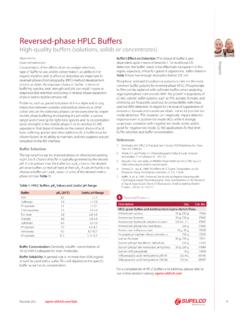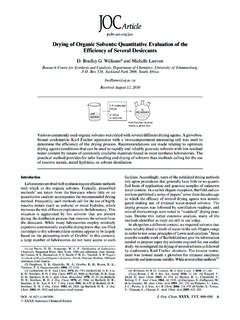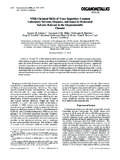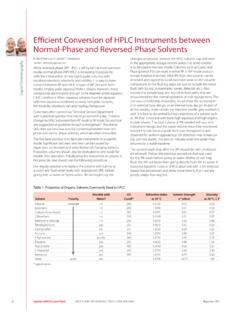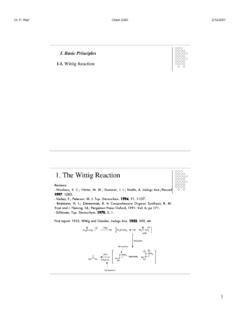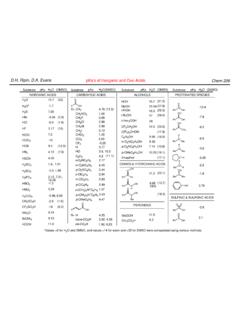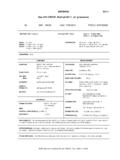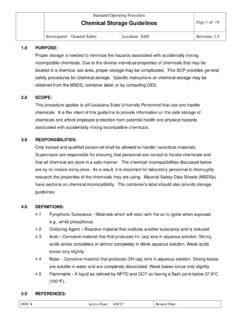Transcription of Incompatibilities of concentrated nitric acid: Never mix ...
1 Incompatibilities of concentrated nitric acid : Never mix concentrated nitric acid and organics, such as acetone, unless you are following a respectable procedure and use a blast shield and proper precautions. Never store mixtures of concentrated acids, particularly nitric acid , and organic or inorganic waste components; immediately dilute any mixtures generated from concentrated acids by slow addition to ice or water in an open plastic container or a plastic bottle behind a shield or hood sash. Chemical Compatibility Chart 1 Inorganic Acids 1 2 Organic acids X 2 3 Caustics X X 3 4 Amines & Alkanolamines X X 4 5 Halogenated Compounds X X X 5 6 Alcohols, Glycols & Glycol Ethers X 6 7 Aldehydes X X X X X 7 8 Ketone X X X X 8 9 Saturated Hydrocarbons 9 10 Aromatic Hydrocarbons X 10 11 Olefins X X 11 12 Petrolum Oils 12 13 Esters X X X 13 14 Monomers & Polymerizable Esters X X X X X X 14 15 Phenols X X X X 15 16 Alkylene Oxides X X X X X X X X 16 17 Cyanohydrins X X X X X X X 17 18 Nitriles X X X X X 18 19 Ammonia X X X X X X X X X 19 20 Halogens X X X X X X X X X X X X 20 21 Ethers X X X 21 22 Phosphorus.
2 Elemental X X X X 22 23 Sulfur, Molten X X X X X X 23 24 acid Anhydrides X X X X X X X X X X 24 X Represents Unsafe Combinations Represents Safe Combinations Group 1: Inorganic Acids Chlorosulfonic acid Hydrochloric acid (aqueous) Hydrofluoric acid (aqueous) hydrogen chloride (anhydrous) hydrogen fluoride (anhydrous) nitric acid Oleum Phosphoric acid Sulfuric acid Group 2: Organic Acids Acetic acid Butyric acid (n-) Formic acid Propionic acid Rosin Oil Tall oil Group 3: Caustics Caustic potash solution Caustic soda solution Group 4: Amines and Alkanolamines Aminoethylethanolamine Aniline Diethanolamine Diethylenetriamine Diisopropanolamine Dimethylamine Ethylenediamine Hexamethylenediamine 2-Methyl-5-ethylpyridine Monoethanolamine Monoisopropanolamine Morpholine Pyridine Triethanolamine Triethlamine Triethylenetetramine Trimethylamine Group 5: Halogenated Compounds Allyl chloride Carbon tetrachloride Chlorobenzene Chloroform Chlorohydrines, crude Dichlorobenzene (o-) Dichlorobenzene (p-) Dichlorodifluoromethane Dichloroethyl ether Dichloropropane Dichloropropene Ethyl chloride Ethylene dibromide Ethylene dichloride Methyl bromide Methyl chloride Methylene chloride Monochlorodifluoromethane Perchloroethylene Propylene dichloride 1,2,4-Trichlorobenzene 1,1,1-Trichloroethane Trichloroethylene Trichlorofluoromethane Group 6.
3 Alcohols, Glycols and Glycol Ethers Allyl alcohol Amyl alcohol 1,4-Butanediol Butyl alcohol (iso, n, sec, tert) Butylene glycol Corn syrup Cyclohexyl alcohol Decyl alcohol (n, iso) Dextrose solution Diacetone alcohol Diethylene glycol Diethylene glycol dimethyl ether Diethylene glycol monobutyl ether Diethylene glycol monoethyl ether Diethylene glycol monomethyl ether Diisobutyl carbitol Dipropylene glycol Dodecanol Ethoxylated dodecanol Ethoxylated pentadecanol Ethoxylated tetradecanol Ethoxylated tridecanol Ethoxytriglycol Ethyl alcohol Ethyl butanol 2-Ethylbuytl alcohol 2-Ethylhexyl alcohol Ethylene glycol Ethylene glycol monobutyl ether Ethylene glycol monoethyl ether Ethylene glycol monomethyl ether Furfuryl alcohol Glycerine Heptanol Hexanol Group 6: Alcohols, Glycols and Glycol Ethers (cont.) Hexylene glycol Isoamyl alcohol Isooctyl alcohol Methyoxytriglycol Methyl alcohol Methylamyl alcohol Molasses, all Nonanol Octanol Pentadecanol Polypropylene glycol methyl ether Propyl alcohols (n, iso) Propylene glycol Sorbitol Tetradecanol Tetraethylene glycol Tridecyl alcohol Triethylene glycol Undecanol Group 7: Aldehydes Acetaldehyde Acrolein (inhibited) Butyraldehyde (n, iso) Crotonaldehyde Decaldehyde (n, iso) 2-Ethyl-3-proplyacrolein Formaldehyde solutions Furfural Hexamethylenetetramine Isooctyl aldehyde Methyl butyraldehyde Methyl formal Paraformaldehyde Valeraldehyde Group 8: Ketones Acetone Acetophenone Camphor oil Cylcohexanone Diisobutyl ketone Isophorone Mesityl oxide Methyl ethyl ketone Methyl isobutyl ketone Group 9.
4 Saturated Hydrocarbons Butane Cyclohexane Ethane Heptane Hexane Isobutane Liquified natural gas Liquified petroleum gas Methane Nonane n-Paraffins Pentane Petrolatum Petroleum ethers Petroleum naphtha Polybutene Propane Propylene butylene polymer Group 10: Aromatic Hydrocarbons Benzene Cumene p-Cymene Coal tar oil Diethybenzene Dodecyl benzene Dowtherm Ethylbenzene Naphtha, coal tar Naphthalene (includes molten) Tetrahdyronaphthalene Toluene Triethyl benzene Xylene (m-, o-, p-) Group 11: Olefins Butylene 1-Decene Dicylcopentadiene Diisobuytlene Dipentene Dodecene 1-Dodecene Ethylene Liquified petroleum gas 1-Heptene 1-Hexane Isobutylene Nonene 1-Octene 1-Pentene Polybutene Propylene Propylene butylene polymer Group 11: Olefins (cont.) Propylene tetramer (dodecene) 1-Tetradecene 1-Tridecene Turpentine 1-Undecene Group 12: Petroleum Oils Asphalt Gasolines Casingead Automotive Aviation Jet Fuels JP-1 (kerosene) JP-3 JP-4 JP-5 (kerosene, heavy) Kerosene Mineral spirits Naphtha (non aromatic) Naphtha Solvent Stoddard solvent VM&P Oils Absorption oil Clarified oil Crude oil Diesel oil Fuel oil No.
5 1 (kerosene) No. 1-D No. 2 No. 2-D No. 4 No. 5 No. 6 Lubricating oil Mineral oil Mineral seal oil Motor oil Penetration oil Range oil Road oil Spindle oil Spray oil Transformer oil Turbine oil Group 13: Esters Amyl acetate Amyl tallate Butyl acetates (n, iso, sec) Butyl benzyl phthalate Castor oil Croton oil Dibutyl phthalate Diethyl carbonate Dimethyl sulfate Dioctyl adipate Dioctyl phthalate Epoxidized vegetable oils Ethyl acetate Ethyl diacetate Ethylene glycol monoethyl ether acetate Ethylhexyl tallate Fish oil Glycol diacetate Methyl acetate Methyl amyl acetate Neatsfoot oil Olive oil Peanut oil Propyl acetates (n, iso) Resin oil Soya bean oil Sperm oil Tallow Tanner s oil Vegetable oil Wax, carnauba Group 14: Monomers and Polymerizable esters Acrylic acid (inhibited) Acrylonitrile Butadiene (inhibited) Butyl acrylate (n, iso) Ethyl acrylate (inhibited) 2-Ethylhexyl acrylate (inhibited) Isodecyl acrylate (inhibited) Isoprene (inhibited) Methyl acrylate (inhibited) Methyl methacrylate (inhibited) o-Propiolactone Styrene (inhibited) Vinyl acetate (inhibited) Vinyl chloride (inhibited) Vinylidene chloride (inhibited) Vinyl toluene Group 15: Phenols Carbolic oil Creosote, coal tar Cresols Nonylphenol Phenol Group 16: Alkylene Oxides Ethylene Oxide Propylene Oxide Group 17: Cyanohydrins Acetone cyanohydrin Ethylene cyanohydrin Group 18: Nitriles Acetonitrile Adiponitrile Group 19: Ammonia Ammonium hydroxide Group 20: Halogens Bromine Chlorine Group 21: Ethers Diethyl ether (ethyl ether) 1, 4, Dioxane Isoprophyl ether Ethers (cont) Tetrahydrofuran Group 22.
6 Phosphorus, elemental Group 23: Sulfur, molten Group 24: acid Anhydride Acetic anhydride Propionic anhydride Mallinckrodt Specialty Chemicals Co. Chemical Compatibility ListThe following provides some chemicals which are incompatible with other contacting, in storage and in working, as explosion or toxic fume or other hazardmay result. (SOURCE: Mallinckrodt Specialty Chemicals Co. 5/89)Incompatible SubstancesCOMPOUND(S)INCOMPATIBLE WITH:Acetic acidchromic acid , nitric acid , ethylene glycol, perchloric acid ,peroxides and permanganatesAcetoneconcentrated sulfuric and nitric acid mixturesAcetylenecopper tubing, fluorine, bromine, chlorine, iodine, silver, mercury Ammonia anhydrousmercury, halogens, calcium hypochlorite, hydrogen fluoride (HF)Ammonium Nitrateacids, metal powders, flammable liquids, chlorates, nitrates, sulfur,finely divided organics or combustiblesAnilinenitric acid , hydrogen peroxideArsenic compoundsany reducing agentAzidesacidsBromineammonia, acetylene, butadiene, butane, hydrogen , sodium carbide,turpentine, finely divided metalsCalciumwater, carbon dioxide, carbon tetrachloride, and chlorinatedhydrocarbonsCarbon, activatedcalcium hypochlorate, all oxidizing agentsChloratesammonium salts, acids, metal powders, sulfur, finely dividedorganics or combustibles, carbonChromic acidacetic acid , naphthalene, camphor, alcohol, glycerine, turpentine,alkalis, other flammable liquidsChlorine Dioxideammonia, methane, phosphine, hydrogen sulfideChlorineammonia, acetylene, butadiene, benzene, petroleum fractions, hydrogen , sodium carbide, turpentine, and finely divided metalpowdersCopperacetylene, hydrogen peroxideCyanidesacids and alkalis (bases)
7 Flammable Liquidsammonium nitrate, chromic acid , hydrogen peroxide, nitric acid ,sodium peroxide, halogensFluorineisolate from everythingHydrazinehydrogen peroxide, nitric acid , all oxidizersHydrocarbonsfluorine, chlorine, bromine, chromic acid , peroxideHydrocyanic acidnitric acid , alkalisHydrofluoric acidammonia, alkalisHydrogen Sulfidefuming nitric acid , oxidizing gasesHypochloritesacids, activated carbonsIodineacetylene, ammonia, hydrogenMercurysulfuric acidNitric acid (conc)acetic acid , aniline, chromic acid , hydrocyanic acid , hydrogensulfide, flammable liquids, flammable gases, copper, brass, heavymetalsNitritesacidNitroparrafinsino rganic bases, aminesOxalic acidssilver, mercuryOxygenoils, grease, hydrogen , flammable liquids, solids or gasesPerchloric Acidacetic anhydride, bismuth, alcohol, paper, wood, oil and greasePeroxides, organicacids, friction, heat, sparksPhosphorous, whiteair, oxygen, alkalis, reducing agentsPhosphorous pentoxide waterPotassiumcarbon tetrachloride, carbon dioxide, waterPotassium chloratesulfuric and other acidsPotassium perchlorate sulfuric and other acids (see Chlorates also)
8 Potassium permanganate glycerol, ethylene glycol, benzaldehyde, sulfuric acidSelenidesreducing agentsSilveracetylene, oxalic acid , tartaric acid , ammonium compounds,fulminic acidSodiumcarbon tetrachloride, carbon dioxide, waterSodium nitriteammonium nitrate and other ammonium saltsSodium peroxideethyl or methyl alcohol, glacial acetic acid , acetic anhydride,benzaldehyde, carbon disulfide, glycerin, ethylene glycol, ethyl ormethyl acetate, furfuralSulfidesacidsSulfuric Acidpotassium (sodium or lithium) chlorate, perchlorate, orpermanganateTelluridesreducing agentsEPA's Chemical Compatibility ChartEPA-600/2-80-076 April 1980A METHOD FOR DETERMINING THE COMPATIBILITY OF CHEMICAL MIXTURES#REACTIVITY GROUP NAME1 Acids, Mineral, Non-oxidizing1 CODE2 Acids, Mineral, Oxidizing2 HHeat Generation3 Acids, OrganicG H 3 FFire4 Alcohols and GlycolsH H FH P4 GInnocuous and non-flammable gas generation5 AldehydesH PH FH P5 GTToxic Gas formation6 AmidesHH GT6 GFFlammable Gas formation7 Amines, Aliphatic and AromaticHH GTHH7 EExplosion8 Azo Compounds, Diazo Compounds and HydrazinesH GH GTH GH GH8 PViolent Polymerization9 CarbamatesH GH GTG H9 SSolubilization of toxic substance10 CausticsHHHHH G10 UMay be hazardous.
9 But Unknown11 CyanidesGT GFGT GFGT GFG 1112 DithiocarbamatesH,F GFH,F GFH,GT GFGF GTUH G1213 EstersHH FH GH1314 EthersHH F1415 Fluorides, InorganicGT GT GT 1516 Hydrocarbons, AromaticH F1617 Halogenated OrganicsH GTH,F GTH GTH GH GFH1718 IsocyanatesH GH,F GTH GH PH PH GH,P GH GU1819 KetonesHH FH GHH1920 Mercaptans and Other Organic SulfidesGT GFH,F GTH GHHH2021 Metals, Alkali and Alkaline Earth, ElementalH,F GFH,F GFH,F GFH,F GFH,F GFGF HGF HGF HGF HGF HGF HGF,H GTGF HH EGF HGF HGF H2122 Metals, Other Elemental & Alloys as Powders, Vapors, or SpongesH,F GFH,F GFG FH,F GTUGF HH EGF HH,F GF2223 Metals, Other Elemental & Alloys as Sheets, Rods, Drops, ,F GFH,F GFH,F GH F2324 Metals and Metal Compounds, ToxicSSSSSS2425 NitridesGF HFH,F EH GFH,E GFGF HUH GUGF HGF HGF HGF HUGF HGF HE 2526 NitrilesH,GT GFH,F GTHUH PSGF H2627 Nitro Compounds, OrganicH,F GTHH EH,E GFH,E GF2728 Hydrocarbons, Aliphatic, UnsaturatedHH FHH E2829 Hydrocarbons, Aliphatic, SaturatedH F2930 Peroxides and Hydroperoxides, OrganicH GH EH FH GH GTH,F EH,F GTH,E GTH,F GTH EHEH.
10 F GTH EH GH GH,E GFH,P GTH P3031 Phenols and CresolsHH FH GH P GF HGF HH3132 Organophosphates, Phosphothioates, PhosphodithioatesH GTH GTUH

